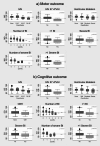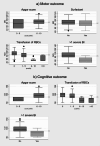CMRI-detected brain injuries and clinical key risk factors associated with adverse neurodevelopmental outcomes in very preterm infants
- PMID: 40415084
- PMCID: PMC12104413
- DOI: 10.1038/s41598-025-02539-1
CMRI-detected brain injuries and clinical key risk factors associated with adverse neurodevelopmental outcomes in very preterm infants
Abstract
Neurological impairment is high after preterm birth. This study evaluates the impact and interplay of cMRI-detected brain injuries (BI) and clinical risk factors on neurodevelopmental outcomes and extracts the most important key factors. A retrospective analysis was conducted on risk factors (perinatal/neonatal, cMRI-detected BI) for adverse motor (MO) and cognitive (CO) outcomes (Bayley Scales of Infant Development, 24 months corrected age) in a tertiary center cohort (2009-2018) of very preterm infants (< 32 weeks of gestation) using uni-/multivariable regression models. We included 342 infants (mean gestational age:28.0 ± 2.3 weeks; male:49%). Significant clinical predictors for MO/CO included GA, birthweight, APGAR score, catecholamine treatment, ventilation, retinopathy of prematurity, transfusion of red blood cells (RBCs), bronchopulmonary dysplasia, surgery, and patent ductus arteriosus interventions (all p < 0.01/p < 0.01), surfactant (MO: p = 0.037), and sepsis (p < 0.001/p = 0.016). (Severe) cMRI-detected BIs (> 1, all p < 0.05) and not only severe intraventricular hemorrhage (IVH) III°/III°+PVHI and ventricular dilatation (VD) (all p < 0.05), but also mild/moderate injuries like IVH II° (p < 0.001/p < 0.024), cerebellar hemorrhage (CO: p = 0.028), and moderate VD (MO: p = 0.005) significantly impacted outcomes. Independent key factors were > 1 severe cMRI-detected BI (MO/CO:-11.27/-10.3 score points (sp), p = 0.021/0.043), APGAR score (10 min, MO/CO:+5.3/+4.45 sp/point, p < 0.001/p < 0.001), surfactant administration (MO:+4.88 sp, p = 0.031), and transfusion of RBCs (MO/CO:-1.69/-1.96 sp/transfusion, p = 0.006/p < 0.001). In conclusion, combining imaging and clinical (key) risk factors is important for risk stratification of preterm infants. Even mild BI, like IVH II°, significantly contributes to adverse outcomes, underlining the importance of cMRI.
Keywords: Brain injuries; Magnetic resonance imaging; Neurodevelopmental outcomes; Pediatric research; Preterm infants.
© 2025. The Author(s).
Conflict of interest statement
Declarations. Competing interests: The authors declare no competing interests.
Figures




Similar articles
-
Incidence of brain injuries in a large cohort of very preterm and extremely preterm infants at term-equivalent age: results of a single tertiary neonatal care center over 10 years.Eur Radiol. 2024 Aug;34(8):5239-5249. doi: 10.1007/s00330-024-10592-z. Epub 2024 Jan 27. Eur Radiol. 2024. PMID: 38279057 Free PMC article.
-
Association of Histologic Chorioamnionitis With Perinatal Brain Injury and Early Childhood Neurodevelopmental Outcomes Among Preterm Neonates.JAMA Pediatr. 2018 Jun 1;172(6):534-541. doi: 10.1001/jamapediatrics.2018.0102. JAMA Pediatr. 2018. PMID: 29610829 Free PMC article.
-
Association of inotrope use with neurodevelopmental outcomes in infants <29 weeks gestation: a retrospective cohort study.J Matern Fetal Neonatal Med. 2022 Dec;35(25):6044-6052. doi: 10.1080/14767058.2021.1904872. Epub 2021 Apr 7. J Matern Fetal Neonatal Med. 2022. PMID: 33827395
-
Neurodevelopmental outcomes of extremely preterm infants with bronchopulmonary dysplasia (BPD) - A retrospective cohort study.Paediatr Respir Rev. 2024 Jun;50:23-30. doi: 10.1016/j.prrv.2024.02.004. Epub 2024 Mar 1. Paediatr Respir Rev. 2024. PMID: 38490918 Review.
-
Early erythropoiesis-stimulating agents in preterm or low birth weight infants.Cochrane Database Syst Rev. 2020 Feb 11;2(2):CD004863. doi: 10.1002/14651858.CD004863.pub6. Cochrane Database Syst Rev. 2020. PMID: 32048730 Free PMC article.
Cited by
-
Influence of oropharyngeal therapy with mother's own milk on the microbiome and metabolome of very preterm infants: a pilot study.Front Nutr. 2025 Aug 1;12:1647379. doi: 10.3389/fnut.2025.1647379. eCollection 2025. Front Nutr. 2025. PMID: 40823026 Free PMC article.
References
-
- Twilhaar, E. S. et al. Profiles of functioning in 5.5-year-old very preterm born children in France: the EPIPAGE-2 study. J. Am. Acad. Child. Adolesc. Psychiatry. 61, 881–891 (2022). - PubMed
MeSH terms
LinkOut - more resources
Full Text Sources
Medical
Miscellaneous

